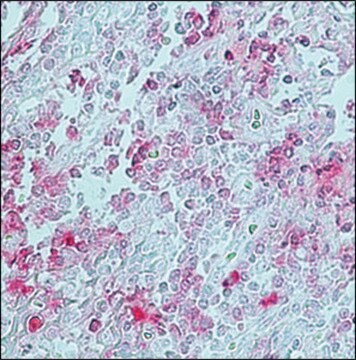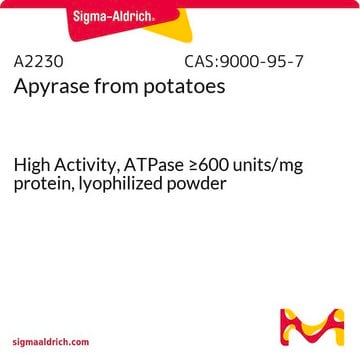A2306
Monoclonal Anti-Rabbit Immunoglobulins−Alkaline Phosphatase antibody produced in mouse
clone RG-16, purified immunoglobulin, buffered aqueous glycerol solution
Sinónimos:
Monoclonal Anti-Rabbit Immunoglobulins (IgG, IgA, IgM)
About This Item
Productos recomendados
biological source
mouse
conjugate
alkaline phosphatase conjugate
antibody form
purified immunoglobulin
antibody product type
secondary antibodies
clone
RG-16, monoclonal
form
buffered aqueous glycerol solution
species reactivity
rabbit
should not react with
pig, chicken, bovine, horse, human, guinea pig, turkey, rat, canine, goat, feline, sheep
technique(s)
direct ELISA: 1:40,000
immunohistochemistry (formalin-fixed, paraffin-embedded sections): 1:160 using human tonsil and Cat. No. I8635 as the primary antibody
western blot: 1:160,000-1:320,000 using detecting β-actin in total cell extract of HeLa cells (5-10 μg per well)
isotype
IgG1
shipped in
wet ice
storage temp.
2-8°C
target post-translational modification
unmodified
¿Está buscando productos similares? Visita Guía de comparación de productos
General description
Specificity
Application
- indirect enzyme linked immunosorbent assay (ELISA)
- immunoblotting
- immunohistochemistry
Biochem/physiol Actions
Mouse monoclonal anti-rabbit immunoglobulins-alkaline phosphatase antibody binds to an epitope on the heavy chain of rabbit IgG, IgA, and IgM. The product stains bands at the intact whole molecule and at the heavy chains in an immunoblot of denatured, non-reduced rabbit immunoglobulins. Reduction of rabbit immunoglobulins destroys the epitope. In ELISA, the product shows no cross reaction with human serum or tissue preparations, nor with human IgA, IgG, or IgM.
Physical form
Disclaimer
Not finding the right product?
Try our Herramienta de selección de productos.
Storage Class
10 - Combustible liquids
wgk_germany
WGK 3
flash_point_f
Not applicable
flash_point_c
Not applicable
ppe
Eyeshields, Gloves, multi-purpose combination respirator cartridge (US)
Certificados de análisis (COA)
Busque Certificados de análisis (COA) introduciendo el número de lote del producto. Los números de lote se encuentran en la etiqueta del producto después de las palabras «Lot» o «Batch»
¿Ya tiene este producto?
Encuentre la documentación para los productos que ha comprado recientemente en la Biblioteca de documentos.
Nuestro equipo de científicos tiene experiencia en todas las áreas de investigación: Ciencias de la vida, Ciencia de los materiales, Síntesis química, Cromatografía, Analítica y muchas otras.
Póngase en contacto con el Servicio técnico








